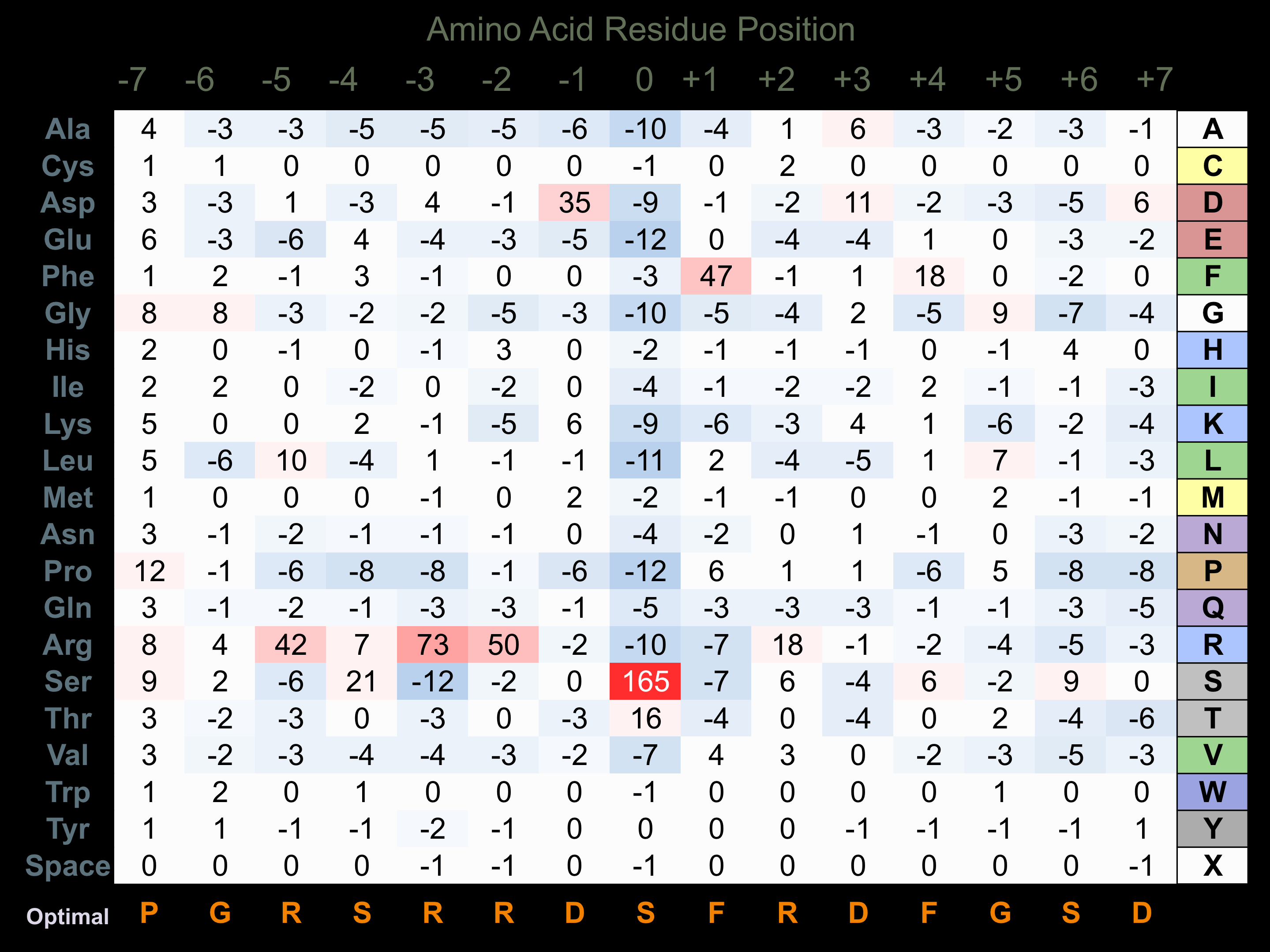Nomenclature
Short Name:
RSK4
Full Name:
Ribosomal protein S6 kinase alpha 6
Alias:
- EC 2.7.1.37
- EC 2.7.11.1
- Ribosomal protein S6 kinase, 90kDa, polypeptide 6
- Ribosomal S6 kinase 4
- RPS6KA6
- S6K-alpha 6
- KS6A6
- P90-RSK 6
- Pp90RSK4
- Ribosomal protein S6 kinase alpha 6
Classification
Type:
Protein-serine/threonine kinase
Group:
AGC
Family:
RSK
SubFamily:
RSK
Structure
Mol. Mass (Da):
83,872
# Amino Acids:
745
# mRNA Isoforms:
2
mRNA Isoforms:
84,093 Da (745 AA; Q9UK32-2); 83,872 Da (745 AA; Q9UK32)
4D Structure:
Forms a complex with either ERK1 or ERK2 in quiescent cells. Transiently dissociates following mitogenic stimulation
1D Structure:
Subfamily Alignment

Domain Distribution:
Kinexus Products
Click on entries below for direct links to relevant products from Kinexus for this protein kinase.
hiddentext
Post-translation Modifications
For detailed information on phosphorylation of this kinase go to PhosphoNET
Acetylated:
K86, K105, K108, K348, K367, K386.
Serine phosphorylated:
S83-, S232+, S372+, S389+, S521, S547, S555, S730, S736.
Threonine phosphorylated:
T94, T236-, T482, T581+, T718.
Tyrosine phosphorylated:
Y149, Y231+, Y239-, Y437, Y474, Y525.
Ubiquitinated:
K86.
Distribution
Based on gene microarray analysis from the NCBI
Human Tissue Distribution
% Max Expression:
Mean Expression:
Number of Samples:
Standard Deviation:
% Max Expression:
Mean Expression:
Number of Samples:
Standard Deviation:
 100
100
654
44
995
 9
9
60
15
112
 5
5
35
13
62
 22
22
141
146
300
 70
70
457
44
386
 2
2
11
92
11
 4
4
29
47
26
 55
55
361
46
563
 36
36
234
17
187
 8
8
50
135
54
 4
4
24
41
46
 95
95
621
158
548
 4
4
25
45
51
 5
5
30
9
42
 4
4
25
17
33
 2
2
15
24
18
 3
3
18
283
20
 5
5
33
30
49
 6
6
42
129
53
 55
55
359
165
334
 4
4
25
36
44
 3
3
20
36
45
 3
3
21
26
35
 5
5
31
31
60
 4
4
24
36
60
 81
81
530
98
552
 3
3
21
45
44
 5
5
32
30
55
 4
4
24
31
45
 15
15
97
56
132
 35
35
232
24
222
 57
57
375
46
451
 26
26
171
115
433
 94
94
614
104
555
 8
8
52
61
44
Evolution
Species Conservation
PhosphoNET % Identity:
PhosphoNET % Similarity:
Homologene %
Identity:
PhosphoNET % Identity:
PhosphoNET % Similarity:
Homologene %
Identity:
 100
100
100
100 0
0
0
98 99.3
99.3
99.4
99 -
-
-
96 -
-
-
- 94.7
94.7
97.8
95 -
-
-
- 85.3
85.3
90.9
88.5 72.8
72.8
83.7
89 -
-
-
- 80.5
80.5
87
- 74.4
74.4
84
88 71.6
71.6
81.7
87 83.8
83.8
90.4
85 -
-
-
- 24.4
24.4
35.9
- -
-
-
- 55
55
69.3
- -
-
-
- -
-
-
- -
-
-
- -
-
-
- -
-
-
- -
-
-
- -
-
-
-
For a wider analysis go to PhosphoNET Evolution in PhosphoNET
Binding Proteins
Examples of known interacting proteins
hiddentext
| No. | Name – UniProt ID |
|---|---|
| 1 | NR4A1 - P22736 |
Regulation
Activation:
Activated by multiple phosphorylations on threonine and serine residues.
Inhibition:
NA
Synthesis:
NA
Degradation:
NA
Protein Kinase Specificity
Matrix of observed frequency (%) of amino acids in aligned protein substrate phosphosites

Matrix Type:
Predicted from the application of the Kinexus Kinase Substrate Predictor Version 2.0 algorithm, which was trained with over 10,000 kinase-protein substrate pairs and 8,000 kinase-peptide substrate pairs.
Domain #:
2
Inhibitors
For further details on these inhibitors click on the Compound Name and enter it into DrugKiNET or click on the ID's
Based on in vitro and/or in vivo phosphorylation data
| Compound Name | KD, Ki or IC50 (nM) | PubChem ID | ChEMBL ID | PubMed ID |
|---|
Disease Linkage
General Disease Association:
Cancer, neurological, eye, and ear disorders
Specific Diseases (Non-cancerous):
Coffin-Lowry syndrome (CLS); Choroideremia (CHM); X-linked nonsyndromic deafness
Specific Cancer Types:
Breast cancer; Kidney cancer
Comments:
The RSK4 gene is frequently found epigenetically inactivated by promoter methylation in cancerous and non-cancerous tissues of breast cancer. It is also a prognostic factor for renal cell carcinoma.
Gene Expression in Cancers:
TranscriptoNET (www.transcriptonet.ca) analysis with mRNA expression data retrieved from the National Center for Biotechnology Information's Gene Expression Omnibus (GEO) database, which was normalized against 60 abundantly and commonly found proteins, indicated altered expression for this protein kinase as shown here as the percent change from normal tissue controls (%CFC) as supported with the Student T-test in the following types of human cancers: Bladder carcinomas (%CFC= -50, p<0.0001); and Papillary thyroid carcinomas (PTC) (%CFC= -62, p<0.002). The COSMIC website notes an up-regulated expression score for RSK4 in diverse human cancers of 630, which is 1.4-fold of the average score of 462 for the human protein kinases. The down-regulated expression score of 8 for this protein kinase in human cancers was 0.1-fold of the average score of 60 for the human protein kinases.
Mutagenesis Experiments:
Insertional mutagenesis studies in mice have not yet revealed a role for this protein kinase in mouse cancer oncogenesis.
Mutation Rate in All Cancers:
Percent mutation rates per 100 amino acids length in human cancers: 0.11 % in 24990 diverse cancer specimens. This rate is a modest 1.51-fold higher than the average rate of 0.075 % calculated for human protein kinases in general.
Mutation Rate in Specific Cancers:
Highest percent mutation rates per 100 amino acids length in human cancers: 0.7 % in 805 skin cancers tested; 0.49 % in 1093 large intestine cancers tested; 0.42 % in 602 endometrium cancers tested; 0.3 % in 589 stomach cancers tested; 0.29 % in 605 oesophagus cancers tested; 0.22 % in 1858 lung cancers tested.
Frequency of Mutated Sites:
None > 5 in 20,274 cancer specimens
Comments:
Eight deletions (7 at A110fs*3), 3 insertion mutations (1 at A110fs*36), and no complex mutations are noted on the COSMIC website.

